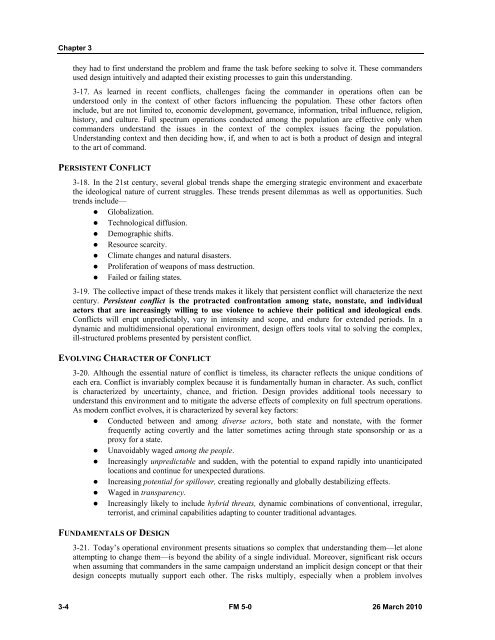FM 5-0, The Operations Process - Federation of American Scientists
FM 5-0, The Operations Process - Federation of American Scientists
FM 5-0, The Operations Process - Federation of American Scientists
Create successful ePaper yourself
Turn your PDF publications into a flip-book with our unique Google optimized e-Paper software.
Chapter 3<br />
they had to first understand the problem and frame the task before seeking to solve it. <strong>The</strong>se commanders<br />
used design intuitively and adapted their existing processes to gain this understanding.<br />
3-17. As learned in recent conflicts, challenges facing the commander in operations <strong>of</strong>ten can be<br />
understood only in the context <strong>of</strong> other factors influencing the population. <strong>The</strong>se other factors <strong>of</strong>ten<br />
include, but are not limited to, economic development, governance, information, tribal influence, religion,<br />
history, and culture. Full spectrum operations conducted among the population are effective only when<br />
commanders understand the issues in the context <strong>of</strong> the complex issues facing the population.<br />
Understanding context and then deciding how, if, and when to act is both a product <strong>of</strong> design and integral<br />
to the art <strong>of</strong> command.<br />
PERSISTENT CONFLICT<br />
3-18. In the 21st century, several global trends shape the emerging strategic environment and exacerbate<br />
the ideological nature <strong>of</strong> current struggles. <strong>The</strong>se trends present dilemmas as well as opportunities. Such<br />
trends include—<br />
• Globalization.<br />
• Technological diffusion.<br />
• Demographic shifts.<br />
• Resource scarcity.<br />
• Climate changes and natural disasters.<br />
• Proliferation <strong>of</strong> weapons <strong>of</strong> mass destruction.<br />
• Failed or failing states.<br />
3-19. <strong>The</strong> collective impact <strong>of</strong> these trends makes it likely that persistent conflict will characterize the next<br />
century. Persistent conflict is the protracted confrontation among state, nonstate, and individual<br />
actors that are increasingly willing to use violence to achieve their political and ideological ends.<br />
Conflicts will erupt unpredictably, vary in intensity and scope, and endure for extended periods. In a<br />
dynamic and multidimensional operational environment, design <strong>of</strong>fers tools vital to solving the complex,<br />
ill-structured problems presented by persistent conflict.<br />
EVOLVING CHARACTER OF CONFLICT<br />
3-20. Although the essential nature <strong>of</strong> conflict is timeless, its character reflects the unique conditions <strong>of</strong><br />
each era. Conflict is invariably complex because it is fundamentally human in character. As such, conflict<br />
is characterized by uncertainty, chance, and friction. Design provides additional tools necessary to<br />
understand this environment and to mitigate the adverse effects <strong>of</strong> complexity on full spectrum operations.<br />
As modern conflict evolves, it is characterized by several key factors:<br />
• Conducted between and among diverse actors, both state and nonstate, with the former<br />
frequently acting covertly and the latter sometimes acting through state sponsorship or as a<br />
proxy for a state.<br />
• Unavoidably waged among the people.<br />
• Increasingly unpredictable and sudden, with the potential to expand rapidly into unanticipated<br />
locations and continue for unexpected durations.<br />
• Increasing potential for spillover, creating regionally and globally destabilizing effects.<br />
• Waged in transparency.<br />
• Increasingly likely to include hybrid threats, dynamic combinations <strong>of</strong> conventional, irregular,<br />
terrorist, and criminal capabilities adapting to counter traditional advantages.<br />
FUNDAMENTALS OF DESIGN<br />
3-21. Today’s operational environment presents situations so complex that understanding them—let alone<br />
attempting to change them—is beyond the ability <strong>of</strong> a single individual. Moreover, significant risk occurs<br />
when assuming that commanders in the same campaign understand an implicit design concept or that their<br />
design concepts mutually support each other. <strong>The</strong> risks multiply, especially when a problem involves<br />
3-4 <strong>FM</strong> 5-0 26 March 2010















